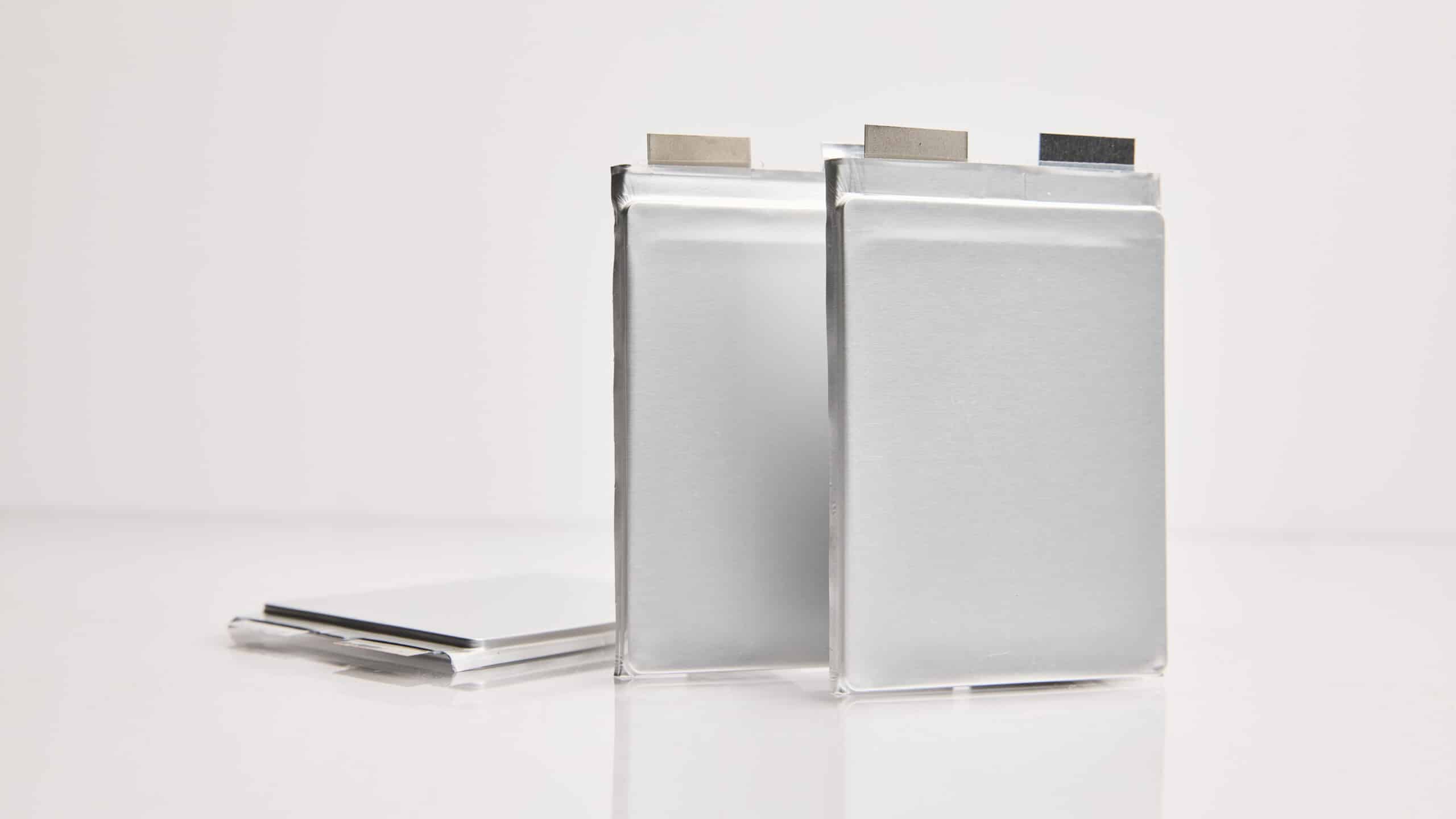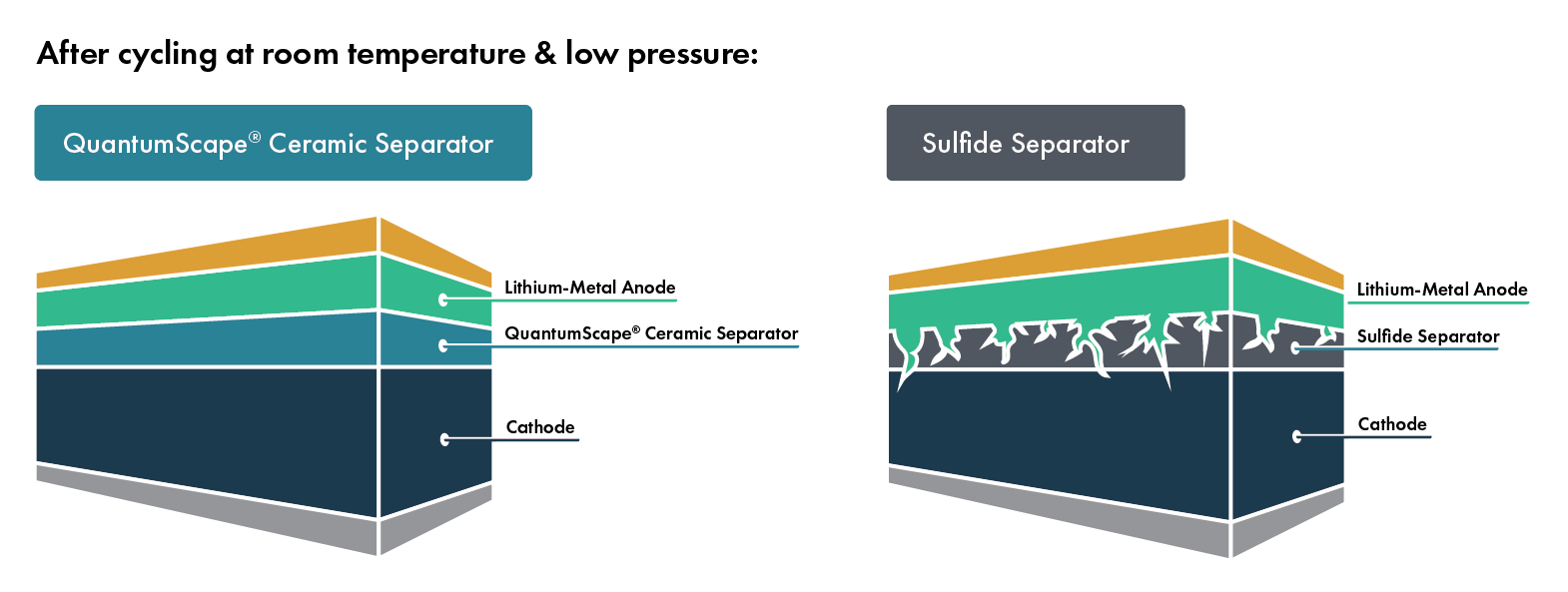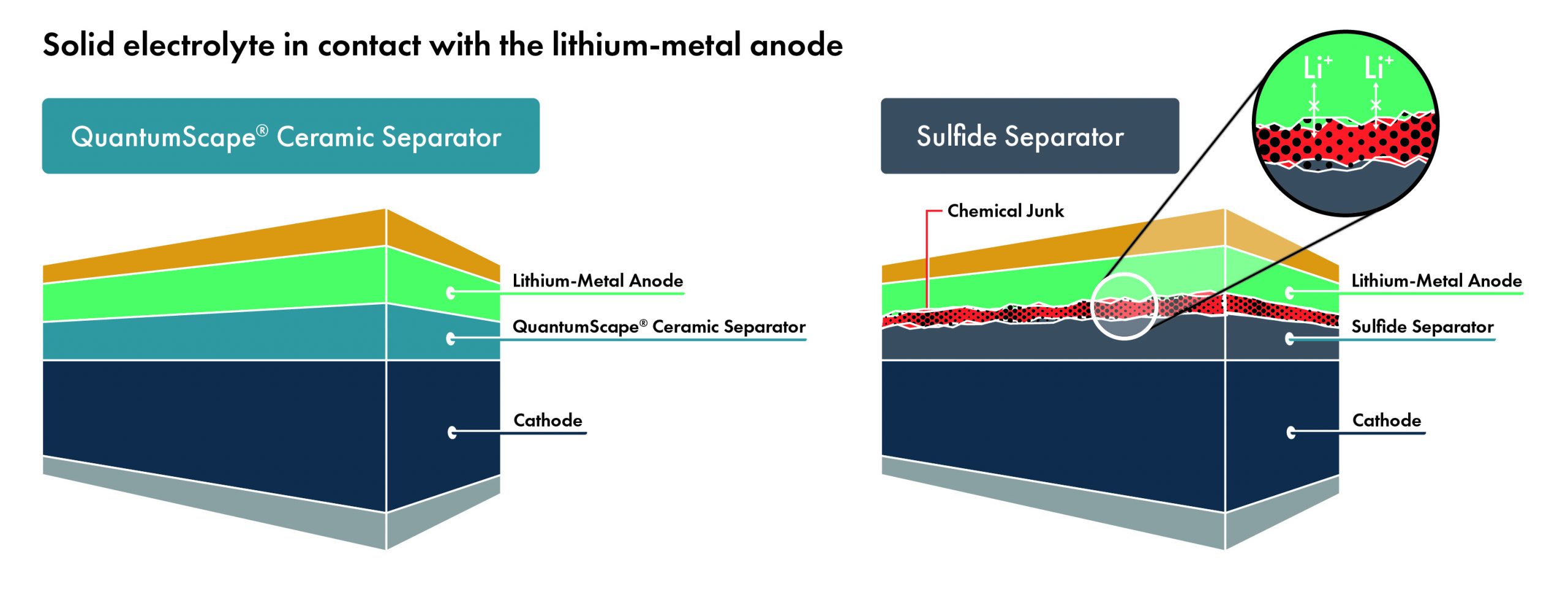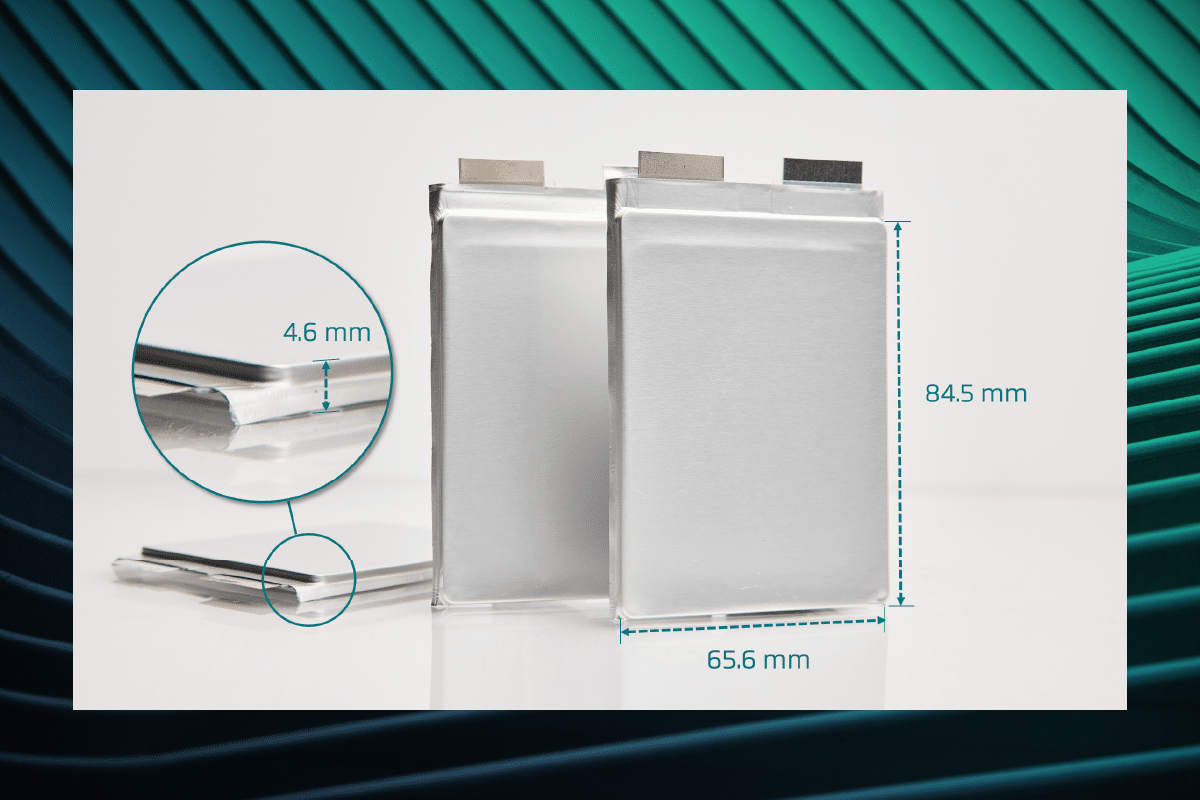
Our Strategic Blueprint
I took on the CEO role last year because I see QuantumScape as the global leader in solid state battery technologies with an ability to revolutionize energy storage and create tremendous shareholder value in the process.
We are often asked about the basic chemistry of solid-state battery materials. Specifically, what’s the composition of your solid electrolyte, and why did you choose that material over others?
The electrolyte has a straightforward role in all types of lithium-ion batteries — it carries lithium ions from one side of the battery to the other. In legacy lithium-ion batteries, this substance is a liquid that fills the whole cell. A thin plastic sheet keeps the two sides of the batteries apart, and the lithium atoms flow in the liquid, through holes in the sheet as they carry their energy during charge and discharge.
In a solid-state battery, the liquid (the electrolyte) and the plastic sheet (the separator) are replaced by a single material: the solid electrolyte. Solids are usually worse than liquids at letting lithium atoms move through them,[1] for much the same reason that it’s harder to swim through ice than through water. Still, there are a few solid materials that let lithium “swim” through them. Some of the most common are sulfides.
It’s important to note that at QuantumScape, we’ve been working for over 10 years to invent and manufacture the best EV batteries possible. We have carefully examined every solid material we could think of — running over three million lab tests — with particular attention to sulfides. Although at first sulfides seemed to have some positive features,[2] after extensive investigation, we concluded that sulfides are not suitable as separators.
So, why did we give up on sulfide-based solid separators? There are three main reasons:
The first and most important reason we don’t think sulfides work as solid separators is the lack of evidence that they prevent dendrites. Dendrites are root-like structures of pure lithium that can grow from the anode[4] of a lithium-metal battery cell. They tear apart the cell from the inside as they grow. When they reach all the way to the cathode,[5] they cause the battery to short-circuit and fail. Dendrites can form even in legacy lithium-ion battery cells, which can cause fires and even explosions.

There are several compromises a cell with a sulfide-based separator can try to work around this problem:
Another problem with sulfide separators is the instability of the chemicals themselves. For example, even if sulfides could prevent lithium dendrites,[12] they’d still react with lithium metal, filling up the anode with chemical junk[13] that limits power output and shortens the battery’s lifespan. Given how important lifespan and power are to drivers, the instability of sulfides will likely limit their attractiveness for passenger EVs.
Sulfides don’t just react with pure lithium; they also react with the chemicals typically found in the cathode, such as the nickel-rich battery materials used in high-performance EVs. Although this problem can be reduced by adding other chemicals,[14] there is still a risk that the battery will begin to degrade on both the anode and the cathode sides if it’s pushed too hard.
Batteries with sulfide-based separators are, therefore, quite sensitive and must be operated with substantial performance limitations. This makes them unattractive to EV drivers, who want to charge quicker and accelerate faster without worrying about hurting their batteries.

This is, in some ways, the most serious problem. As mentioned above, sulfides are very reactive. One of the things sulfides react with is water, and when they come into contact with water or humidity, they produce a gas known as hydrogen sulfide.[15] Hydrogen sulfide gas is extremely toxic, flammable, and can be explosive — it was used as a chemical weapon in World War I and has killed dozens of workers in industrial accidents over the years.
Keeping water away from sulfide materials during manufacturing is a serious, complex, and expensive challenge — even a small amount of humidity in the air can lead to deadly levels of hydrogen sulfide buildup. And a manufacturing defect or car accident could lead to the battery cells being exposed to water while in use, potentially causing a fire or poisoning the car’s occupants.
One of the key benefits of solid-state batteries is the promise of improved safety but using a sulfide-based solid separator creates a new set of very serious risks.
In contrast to sulfide-based approaches, QuantumScape’s sulfide-free ceramic separator has been shown to prevent the formation of dendrites under practical conditions; this previous blog post covers the conditions under which we test our batteries. Our separator is stable against the high-performance lithium-metal anode and does not produce dangerous byproducts if it touches water.
These advantages improve performance, safety, and manufacturability, and are ultimately why QuantumScape is not using a sulfide separator. Though sulfides looked promising when we started our work a decade ago, and we investigated them thoroughly, we believe the obstacles faced by sulfide separators are incredibly challenging, and perhaps even insurmountable.
[1] Battery scientists refer to this concept as “ionic conductivity.” The higher the conductivity, the lower the resistance.
[2] The properties that got scientists interested in sulfides were their relatively high ionic conductivity and the ability to process them at lower temperatures.
[3] More precisely, they have a narrow range of voltage stability.
[4] The negative side.
[5] The positive side.
[6] When there is extra material added to the anode to help store the lithium ions and prevent dendrites from forming, this material is called the “host.” Batteries with hosted anodes include all legacy lithium-ion batteries and most other solid-state batteries that we are aware of.
[7] This is because the hosted anode takes up space, adds materials and manufacturing costs, and represents a bottleneck in the flow of lithium ions that puts a fundamental limit on charge speed.
[8] This data was disclosed by Solid Power CEO Doug Campbell at an investor presentation held by Key Bank.
[9] Sulfide tests are often reported at temperatures between 60-80 °C.
[10] Elevated temperatures also reduce the internal resistance of the cell, covering up deficiencies in the design of the cell.
[11] Battery researchers call this concept “current density.”
[12] We have found no evidence that they can.
[13] The technical term is “electrochemical decomposition by-products.”
[14] Many sulfide-based approaches deal with the poor stability of sulfides by coating the cathode material with less reactive materials. However, such additions can increase the internal resistance of the cell, reducing its power capability.
[15] H2S
Forward-Looking Statements
This article contains forward-looking statements within the meaning of the federal securities laws and information based on management’s current expectations as of the date of this current report. All statements other than statements of historical fact contained in this article, including statements regarding the future development of QuantumScape’s battery technology, the anticipated benefits of QuantumScape’s technologies and the performance of its batteries, and plans and objectives for future operations, are forward-looking statements. When used in this current report, the words “may,” “will,” “estimate,” “pro forma,” “expect,” “plan,” “believe,” “potential,” “predict,” “target,” “should,” “would,” “could,” “continue,” “believe,” “project,” “intend,” “anticipates” the negative of such terms and other similar expressions are intended to identify forward-looking statements, although not all forward-looking statements contain such identifying words.
These forward-looking statements are based on management’s current expectations, assumptions, hopes, beliefs, intentions, and strategies regarding future events and are based on currently available information as to the outcome and timing of future events. These forward-looking statements involve significant risks and uncertainties that could cause the actual results to differ materially from the expected results. Many of these factors are outside QuantumScape’s control and are difficult to predict. QuantumScape cautions readers not to place undue reliance upon any forward-looking statements, which speak only as of the date made. Except as otherwise required by applicable law, QuantumScape disclaims any duty to update any forward-looking statements. Should underlying assumptions prove incorrect, actual results and projections could differ materially from those expressed in any forward-looking statements. Additional information concerning these and other factors that could materially affect QuantumScape’s actual results can be found in QuantumScape’s periodic filings with the SEC. QuantumScape’s SEC filings are available publicly on the SEC’s website at www.sec.gov.

I took on the CEO role last year because I see QuantumScape as the global leader in solid state battery technologies with an ability to revolutionize energy storage and create tremendous shareholder value in the process.

QuantumScape’s planned first commercial product, QSE-5, is a ~5 amp-hour cell designed to meet the requirements of automotive applications. Here, we’ll walk through the various elements of the cell specifications and explain some of the complexities behind the seemingly simple metric of energy density.

I took on the CEO role last year because I see QuantumScape as the global leader in solid state battery technologies with an ability to revolutionize energy storage and create tremendous shareholder value in the process.

QuantumScape’s planned first commercial product, QSE-5, is a ~5 amp-hour cell designed to meet the requirements of automotive applications. Here, we’ll walk through the various elements of the cell specifications and explain some of the complexities behind the seemingly simple metric of energy density.
Privacy Policy | Terms of Use
© 2025 QuantumScape Battery, Inc.
1730 Technology Drive, San Jose, CA 95110
info@quantumscape.com

Pamela Fong is QuantumScape’s Chief of Human Resources Operations, leading people strategy and operations, including talent acquisition, organizational development and employee engagement. Prior to joining the company, Ms. Fong served as the Vice President of Global Human Resources at PDF Solutions (NASDAQ: PDFS), a semiconductor SAAS company. Before that, she served in several HR leadership roles at Foxconn Interconnect Technology, Inc., a multinational electronics manufacturer, and NUMMI, an automotive manufacturing joint venture between Toyota and General Motors. Ms. Fong holds a B.S. in Business Administration from U.C. Berkeley and a M.S. in Management from Stanford Graduate School of Business.